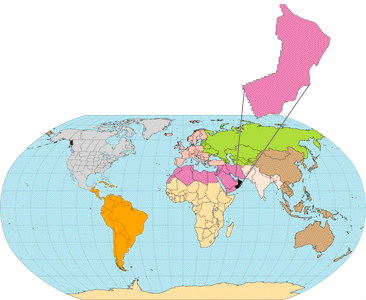
![]()
U.S. DEPARTMENT OF THE INTERIOR
U.S. GEOLOGICAL SURVEY
|
By
|

Open-File Report 99-50-C
| boundary
outlines the maximum geographic extent at which similar undiscovered fields
may exist in the Middle Cretaceous Natih(!) TPS and is independent of the
North Oman Huqf — Shu'aiba(!) TPS (201601).
At present, only eight fields (table 2) are allocated to the Middle Cretaceous Natih(!) TPS and Natih-Fiqa Structural/Stratigraphic Assessment Unit with most of the recoverable oil in the two giant fields, Fahud and Natih. Subsequently, only smaller, marginally economic discoveries were made in fields along the Maradi Fault zone. Shows of Natih oils have also been identified in at least seven other fields or wells (Terken, in press). Exploration and new-field discoveries in this assessment unit are estimated using the data and interpretations of Lake (1996), Loosvelt and others (1996), and Terken (in press). Future discoveries will be from more subtle trap syles including: 1. structural traps related to
foreland basin development that include faulted-dip/trunca- tion closures
on the northern flank of the foreland bulge, and traps above salt domes
with late Tertiary movement.
Size and number of new economic discoveries may be limited due to: 1. presence/absence of the massive
top Fiqa shale seal.
Three Total Petroleum Systems and their associated assessment units have been interpreted in this study for the Ghaba and Fahud Salt Basin Provinces of north-central Oman. The boundary for each Total Petroleum System also defines a boundary that corresponds to an assessment unit and incorpo- rates all trap styles and reservoirs of the produced hydrocarbons.
|
|||
|
In both the Ghaba and Fahud Salt Basins, hydrocarbons were generated from
several deeply-buried source-rock units of the Infracambrian Huqf Supergroup.
Although one general `North Oman Huqf' type oil is dominant in the Fahud
Salt Basin, oils in the Ghaba Salt Basin can be linked to at least two
distinct Huqf source-rock units, commonly found as admixtures, the general
North Oman Huqf-type oil source and a more dominant `questionable unidentified-source'
or `Q'-type Huqf oil source.
Hydrocarbons generated from Huqf sources are produced from a variety of reservoir types and ages in both the Ghaba and Fahud Salt Basin Provinces. Clastic reservoirs of the Gharif and Al Khlata Formations, Haushi Group (M. Carboniferous to L. Permian), dominate oil production in the Ghaba Salt Basin Province. In contrast, Cretaceous carbonates of the Shu'aiba and Natih limestones account for most of the production in the Fahud Salt Basin. Deep gas is produced mainly from Middle Cambrian to Lower Ordovician clastic reservoirs of the Haima Supergroup with future potential in deeper Huqf reservoirs. Traps are mainly structural in origin and were formed by one or more mechanisms during periodic halokinesis of the thick Cambrian Ara Salt beginning with the deposition of the thick Haima clastics and from consequent folding and faulting from basin loading, rifting, and tectonics forming the Oman Mountains and associated foreland-basin system during the Late Cretaceous-Early Tertiary. Most of the future new-field discoveries will likely target low-relief structures, as many of the large structures have been drilled, and will target deep gas in the Haima and Huqf Supergroups. The Middle Cretaceous Natih Total Petrolum System is a small efficient system of the Fahud Salt Basin Province producing primarily from Natih reservoirs along fault-dip structures. Most traps are structural and are related to development of the foreland basin and formation of the Oman Mountains. Future targets will be less obvious than those of Fahud and Natih fields and frontier exploration in stratigraphic traps within Natih buildups and in unproven turbidite and other marine clastics of the Fiqa Formation. |
| <<PREVIOUS |
NEXT>>
|
| To Top of this Report |